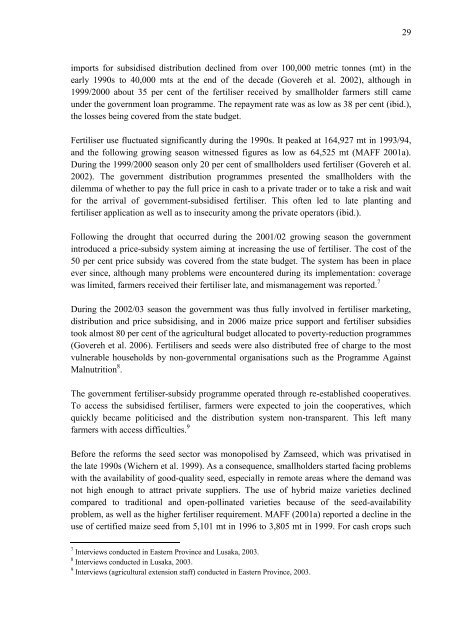Rural Income Generation and Diversification - A Case Study ... - Doria
Rural Income Generation and Diversification - A Case Study ... - Doria
Rural Income Generation and Diversification - A Case Study ... - Doria
You also want an ePaper? Increase the reach of your titles
YUMPU automatically turns print PDFs into web optimized ePapers that Google loves.
imports for subsidised distribution declined from over 100,000 metric tonnes (mt) in the<br />
early 1990s to 40,000 mts at the end of the decade (Govereh et al. 2002), although in<br />
1999/2000 about 35 per cent of the fertiliser received by smallholder farmers still came<br />
under the government loan programme. The repayment rate was as low as 38 per cent (ibid.),<br />
the losses being covered from the state budget.<br />
Fertiliser use fluctuated significantly during the 1990s. It peaked at 164,927 mt in 1993/94,<br />
<strong>and</strong> the following growing season witnessed figures as low as 64,525 mt (MAFF 2001a).<br />
During the 1999/2000 season only 20 per cent of smallholders used fertiliser (Govereh et al.<br />
2002). The government distribution programmes presented the smallholders with the<br />
dilemma of whether to pay the full price in cash to a private trader or to take a risk <strong>and</strong> wait<br />
for the arrival of government-subsidised fertiliser. This often led to late planting <strong>and</strong><br />
fertiliser application as well as to insecurity among the private operators (ibid.).<br />
Following the drought that occurred during the 2001/02 growing season the government<br />
introduced a price-subsidy system aiming at increasing the use of fertiliser. The cost of the<br />
50 per cent price subsidy was covered from the state budget. The system has been in place<br />
ever since, although many problems were encountered during its implementation: coverage<br />
was limited, farmers received their fertiliser late, <strong>and</strong> mismanagement was reported. 7<br />
During the 2002/03 season the government was thus fully involved in fertiliser marketing,<br />
distribution <strong>and</strong> price subsidising, <strong>and</strong> in 2006 maize price support <strong>and</strong> fertiliser subsidies<br />
took almost 80 per cent of the agricultural budget allocated to poverty-reduction programmes<br />
(Govereh et al. 2006). Fertilisers <strong>and</strong> seeds were also distributed free of charge to the most<br />
vulnerable households by non-governmental organisations such as the Programme Against<br />
Malnutrition 8 .<br />
The government fertiliser-subsidy programme operated through re-established cooperatives.<br />
To access the subsidised fertiliser, farmers were expected to join the cooperatives, which<br />
quickly became politicised <strong>and</strong> the distribution system non-transparent. This left many<br />
farmers with access difficulties. 9<br />
Before the reforms the seed sector was monopolised by Zamseed, which was privatised in<br />
the late 1990s (Wichern et al. 1999). As a consequence, smallholders started facing problems<br />
with the availability of good-quality seed, especially in remote areas where the dem<strong>and</strong> was<br />
not high enough to attract private suppliers. The use of hybrid maize varieties declined<br />
compared to traditional <strong>and</strong> open-pollinated varieties because of the seed-availability<br />
problem, as well as the higher fertiliser requirement. MAFF (2001a) reported a decline in the<br />
use of certified maize seed from 5,101 mt in 1996 to 3,805 mt in 1999. For cash crops such<br />
7<br />
Interviews conducted in Eastern Province <strong>and</strong> Lusaka, 2003.<br />
8<br />
Interviews conducted in Lusaka, 2003.<br />
9<br />
Interviews (agricultural extension staff) conducted in Eastern Province, 2003.<br />
29

















